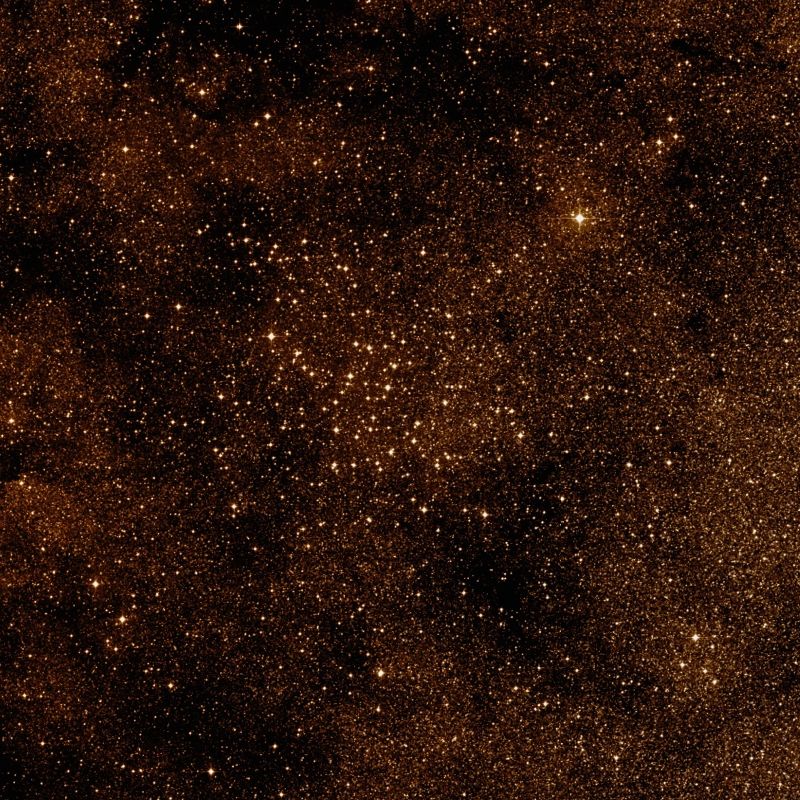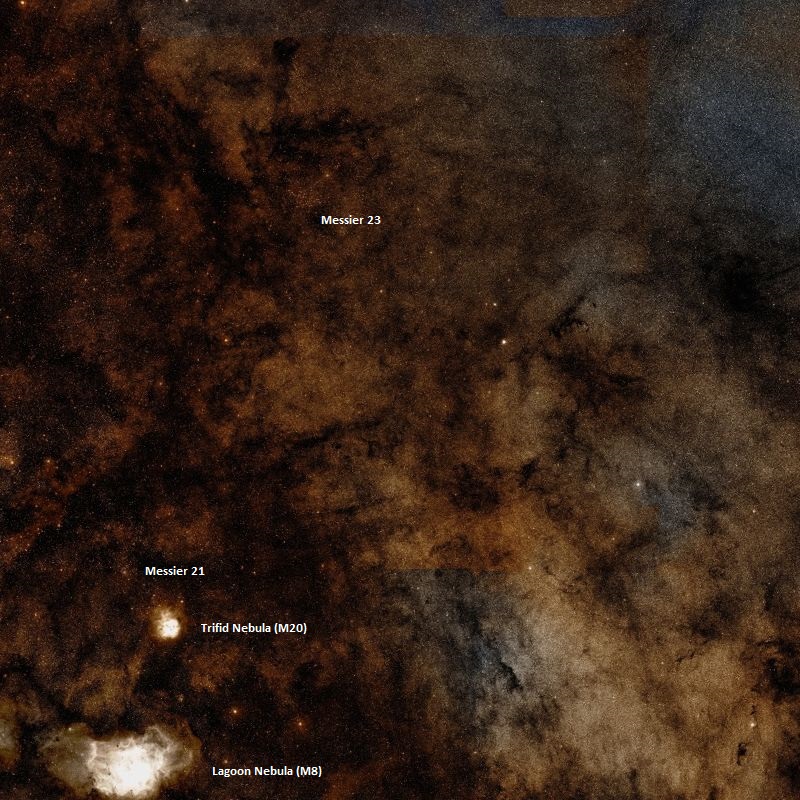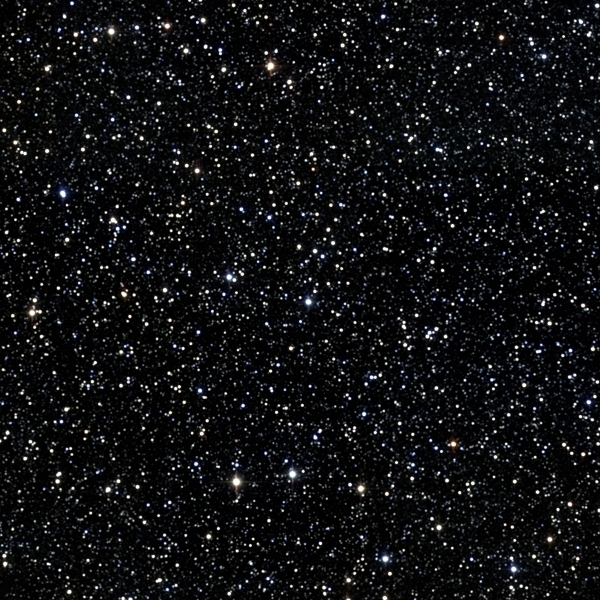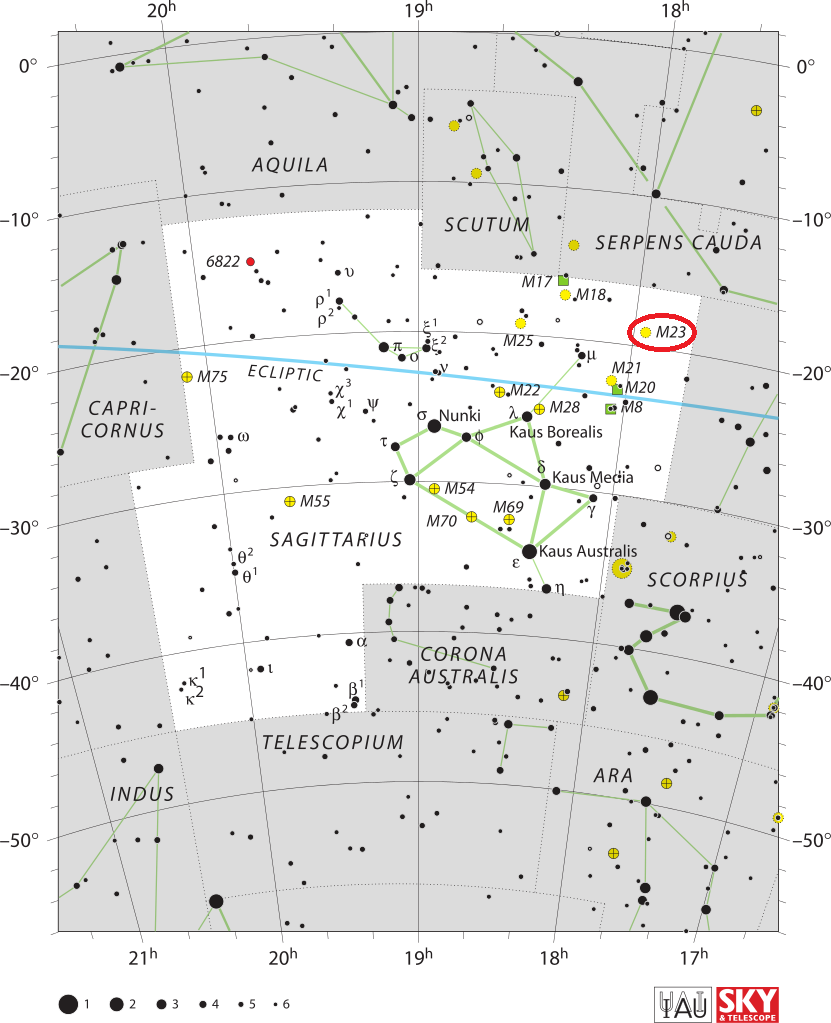Messier 23 (M23) is a bright, large open star cluster located in the constellation Sagittarius. The cluster lies at a distance of 2,150 light years, or 659 parsecs, from Earth and has an apparent magnitude of 6.9. It has the designation NGC 6494 in the New General Catalogue.
Messier 23 has a radius of 15 to 20 light years and contains 176 confirmed members. Most stars in the cluster are between 10th and 13th magnitude, and about 100 stars are brighter than magnitude 13.5. M23 has an estimated age of at least 220 million years, which makes it one of the older known open clusters in our galaxy.
Messier 23 can easily be seen in binoculars and is best viewed in small and moderate-sized telescopes. 6-inch and 8-inch telescopes will resolve dozens of the cluster’s stars.
The cluster lies northwest of the Teapot asterism, formed by the brightest stars of Sagittarius. M23 is located just to the northwest of Mu Sagittarii, a multiple star system with an apparent magnitude of 3.84, visible to the naked eye. The cluster can be found 2.5 degrees north and 3.5 degrees west of the star.
In binoculars, M23 appears as a hazy smudge with barely resolvable stars. Small telescopes at low magnifications will reveal the cluster’s brightest stars and HIP 87782 (HR 6679), a particularly bright, magnitude 6.52 star appearing at the northwest corner of M23. HIP 87782 is a white main sequence star only 320 light years distant from the solar system. It is not a member of M23, but merely lies in the foreground of the cluster.

Messier 23 is located in an area of the sky rich in Messier objects and lies slightly to the north of the more famous Messier 20 (the Trifid Nebula), Messier 8 (the Lagoon Nebula), and the open cluster Messier 21.
Messier 23 occupies an area of 27 arc minutes of apparent sky, roughly the size of a full Moon. It has a linear diameter of 15 light years. M23 is classified as Trumpler I 2 r cluster, which means that it has a strong central concentration and is detached from the surrounding star field (I), its stars have a moderate range in brightness (2), and the cluster is rich in stars, containing more than 100 members.
The brightest star in M23 is an extremely hot and luminous star with the spectral classification B9 and a visual magnitude of 9.2.

The open cluster was discovered by Charles Messier on June 20, 1764. Messier described the object as a “star cluster, between the end of the bow of Sagittarius & the right foot of Ophiuchus, very near to 65 Ophiuchi, according to Flamsteed. The stars of this cluster are very close to one another. Its position was determined from Mu Sagittarii. (diam. 15′)”
This is what he wrote in the first Messier catalogue (1771):
In the night of June 20 to 21, 1764, I determined the position of a cluster of small stars which is situated between the northern extremity of the bow of Sagittarius & the right foot of Ophiuchus, very close to the star of sixth magnitude, the sixty-fifth of the latter constellation [Oph], after the catalog of Flamsteed: These stars are very close to each other; there is none which one can see easily with an ordinary [non-achromatic] refractor of 3 feet & a half, & which was taken for these small stars. The diameter of all is about 15 minutes of arc. I have determined its position by comparing the middle with the star Mu Sagittarii: I have found its right ascension of 265d 42′ 50″, & its declination of 18d 45′ 55″, south.

William Herschel observed the cluster on June 18, 1784 and provided the following description:
A cluster of beautiful scattered, large stars, nearly of equal magnitudes (visible in my finder), it extends much farther than the field of the telescope will take in, and in the finder seems to be a nebula of a lengthened form extending to about half a degree.
Admiral William Henry Smyth offered a more detailed description of M23 after observing it in July 1835:
A loose cluster in the space between Ophiuchus‘s left leg and the bow of Sagittarius. This is an elegant sprinkling of telescopic stars over the whole field, under a moderate magnifying power; the most clustering portion is oblique, in the direction sp to nf [south preceding to north following, SW to NE], with a 7th-magnitude star in the latter portion. The place registered it that of a neat pair, of the 9th and 10th magnitudes, of a lilac hue, and about 12″ apart. This object was discovered by Messier in 1764, and it precedes a rich out-cropping of the Milky Way. The place is gained by differentiating the cluster with Mu Sagittarii, from which it bears north-west, distant about 5 deg, the spot being directed to by a line from Sigma on the shoulder, through Mu at the tip of the bow.
After having examined this object, I lowered the telescope a couple of degrees, and gazed for the curious trifid nebula, 41 H. IV [H IV.41]; but though I could make out the delicate triple star in the centre of its opening, the nebulous matter resisted the light of my telescope, so that its presence was only indicated by a peculiar glow. Pretty closely preceding this is No. 20 M., an elegant cruciform group of stars, discovered in 1764, which he considered to be surrounded with nebulosity.
FACTS
| Object: Cluster |
| Type: Open |
| Designations: Messier 23, M23, NGC 6494, Collinder 356, C 1753-190, MWSC 2757 |
| Constellation: Sagittarius |
| Right ascension: 17h 56.8m |
| Declination: -19°01′ |
| Distance: 2,150 light years (659 parsecs) |
| Age: 220 million years |
| Number of stars: 176 |
| Apparent magnitude: +6.9 |
| Apparent dimensions: 27′ |
| Radius: 8 light years |
LOCATION
